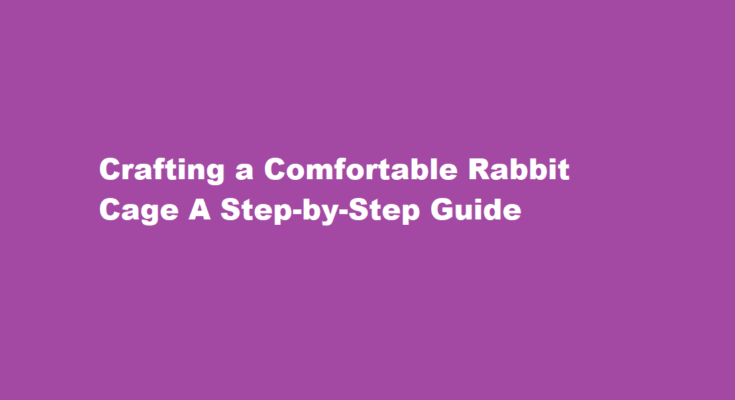Introduction
Rabbits are delightful and gentle creatures that make wonderful pets. Providing them with a safe and comfortable living space is essential for their well-being. A well-constructed rabbit cage is a crucial element of their habitat. While you can purchase pre-made cages, creating one yourself allows for customization and ensures it meets your rabbit’s specific needs. In this comprehensive guide, we will walk you through the process of building a rabbit cage step by step, enabling you to provide your furry friend with a cozy and secure home.
Materials You Will Need
Before you begin, gather the necessary materials. You will need:
1. Wire mesh or hardware cloth
2. Wooden boards or PVC pipes
3. Screws or zip ties
4. Hinges and latches
5. A saw, wire cutters, and pliers
6. Measuring tape
7. A hammer and nails (if using wooden boards)
8. A drill (if using PVC pipes)
9. Flooring material (e.g., vinyl or linoleum)
10. Optional: paint or stain for aesthetics
Planning
Start by planning your rabbit cage. Consider the size and breed of your rabbit, as well as the available space in your home or yard. A general guideline is to provide at least 12 square feet of space for a medium-sized rabbit. Sketch out your design, including dimensions, access points, and any additional features like ramps or hideaways. Planning ahead will save time and ensure your cage is both functional and comfortable for your rabbit.
Frame Construction
If you’re using wooden boards, cut them to the desired lengths for the top, bottom, sides, and back of the cage. Assemble the frame by attaching the pieces with screws. Ensure the corners are square and secure. If you prefer PVC pipes, cut them into appropriate lengths and use connectors to create the frame. PVC is lightweight and easy to work with, making it a popular choice for DIY cages.
Mesh Installation
Cover the frame with wire mesh or hardware cloth. Secure it using zip ties or screws, ensuring there are no sharp edges that could harm your rabbit. Use a sturdy gauge of wire to prevent your rabbit from chewing through it. Leave one side open for easy access. The mesh provides ventilation and allows your rabbit to see its surroundings while keeping it safe and contained.
Flooring
For the cage floor, consider using a smooth, washable material like vinyl or linoleum. This makes cleaning easier and provides a comfortable surface for your rabbit to hop around on. Secure the flooring in place, making sure there are no loose edges or gaps where your rabbit’s foot could get stuck.
Access Points
Install a hinged door on one side of the cage for easy access. Use hinges and latches to ensure it stays securely closed but can be opened when needed. Having a door makes it easier to clean the cage, replenish food and water, and interact with your rabbit.
Optional Additions
Enhance your rabbit’s cage with optional features like ramps, hideaways, and hanging toys. Ramps can provide exercise and mental stimulation, while hideaways create a sense of security. Hanging toys keep your rabbit entertained and active. Ensure that any additions are securely fastened and free from hazards like sharp edges or small parts that your rabbit could ingest.
Finishing Touches
If desired, paint or stain the wooden parts of the cage with non-toxic, rabbit-safe products. This step is purely aesthetic but can make your DIY rabbit cage blend seamlessly into your home decor.
Frequently Asked Questions
What is needed in a rabbit cage?
Minimum size 30”x30”x24” for a 5-6 lb. adult bunny. Include litter box, food bowl, water bowl or bottle, and toys. If the cage has a wire bottom, protect bunny’s feet by placing a doormat or other solid flooring item on part of the floor area.
How do you take care of a rabbit cage?
Remove any uneaten fresh foods from the cage daily. Ideally, do this twice daily, once in the morning and again at night. Wash out the food bowl(s). Wash and refill the water bottle.
Conclusion
Building a rabbit cage allows you to create a personalized and comfortable living space for your furry companion. With careful planning and the right materials, you can craft a cage that meets your rabbit’s specific needs while ensuring its safety and well-being. Remember to provide ample space, ventilation, and engaging features to keep your rabbit happy and healthy. Regular cleaning and maintenance are essential to ensure a hygienic environment. By following this step-by-step guide, you can embark on a rewarding DIY project that benefits both you and your beloved rabbit.
Read Also : Creating a Safe Haven A Step-by-Step Guide on How to Build a Cage for Your Parrot



